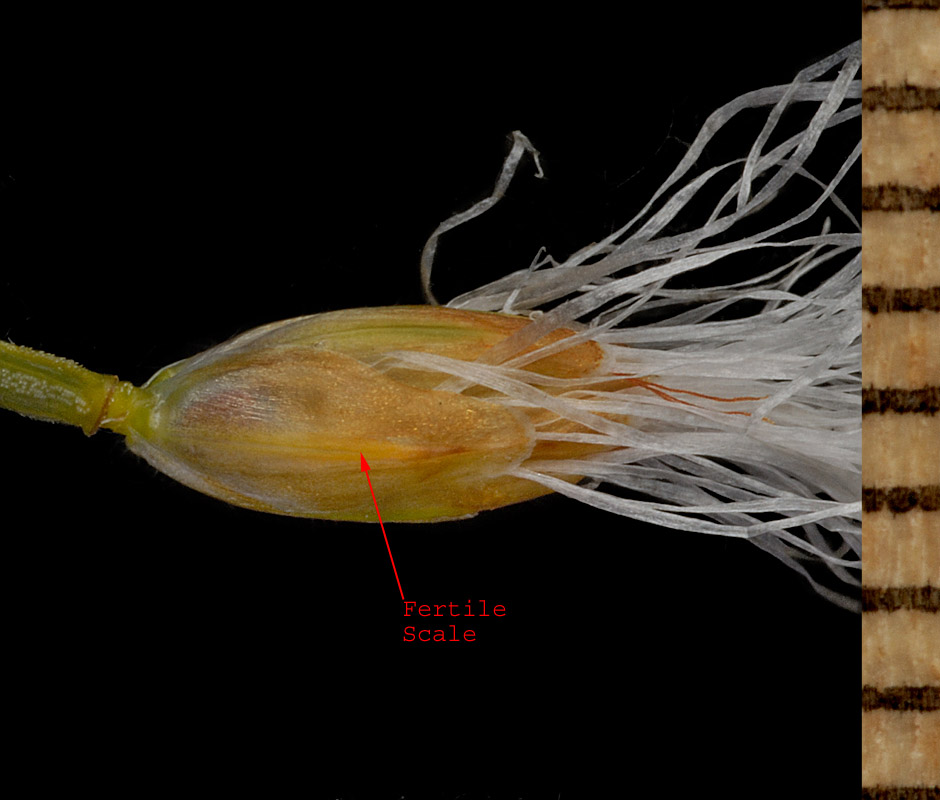 |
Alpinum: Answers
to key questions in Rushes, Bulrushes & Pondweeds plus the remaining
Monocots of Saskatchewan by V. L. Harms, A. L. Leighton, and M. A. Vetter
leading to this species. The answers are in the
order you would normally work through the key.
 |
Culms
trigonous with angles scabrous at least distally. NOT [Culms
terete with surface smooth (not scabrous).] |
 |
Scales 15
- 20+ per spikelet; spikelets 5.4 - 8 mm long; bristles bright white,
smooth, flattened, much longer than achenes; leaf blades 6 - 9 mm long.
NOT [Scales 3 - 6 per spikelet; spikelets 3.4 - 5.3 mm long; bristles
pale brown, scabrous, terete, equaling or shorter than achenes; leaf
blades (6) 15 - 250 mm long.]
|
|
 |
Trichophorum: Answers
to key questions in Rushes, Bulrushes & Pondweeds plus the remaining
Monocots of Saskatchewan by V. L. Harms, A. L. Leighton, and M. A. Vetter
leading to this genus. The
answers are in the order you would normally work through the key.
 |
Flowers
and achenes naked in the axils of scales, not enclosed in a sac; flowers
usually perfect (sometimes some flowers imperfect in Cyperus,
Rhynchospora and Cladium). NOT [Flowers and achenes enclosed in a
sac (perigynium) borne in the axils of scales; flowers imperfect.] |
 |
Perianth
bristles absent or up to 6 per flower; if more than 6, then only
somewhat longer than the achenes. NOT [Perianth bristles usually
more than 10 per flower, much longer than the achenes, conspicuously
elongated to over 10 mm long in fruit stage and usually obscuring most
scales in spikelets.] |
 |
Inflorescence
not a solitary, terminal spike; if solitary, terminal and spike-like,
then inflorescence +/- terete. NOT [Inflorescence a compressed,
solitary, terminal spike bearing few-flowered spikelets attached in 2
rows.] |
 |
Inflorescence
a solitary terminal spikelet; inflorescence bracts absent or up to 8 mm
long and only slightly longer than the spikelet; achenes usually <= 2
mm long (up to 2.3 mm in Eleocharis quinqueflora). NOT
[Inflorescence usually with > 1 spikelet; if only 1 spikelet present,
then inflorescence bract usually 10 - 200 mm long (but as short as 7 mm
in Schoenoplectus subterminalis) and achenes 2 - 3.5 mm long.] |
 |
Leaf
sheaths with short to long blades; inflorescence bracts present (may be
absent at maturity because deciduous but will leave a scar) up to 8 mm
long and only slightly longer than spikelets; scales 3 - 20+ per
spikelet; achenes lacking a tubercle but sometimes beaked. NOT
[Leaf sheaths lacking blades; inflorescence bracts absent (subproximal
and proximal scales, especially those lacking flowers, might be mistaken
for very short bracts); scales 3 - 500 per spikelet; achenes usually
bearing a clearly differentiated tubercle (but see Eleocharis
quinqueflora and E. coloradoensis).]
|
|

